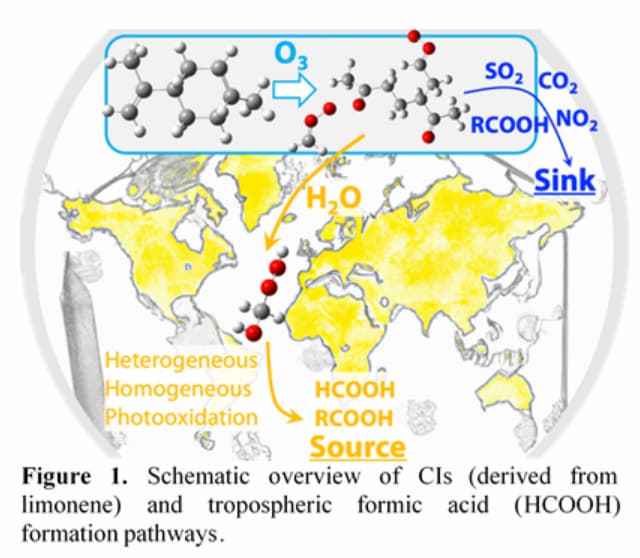Impact of the Stabilized Criegee Intermediates Chemistry on Tropospheric Formic Acid Distribution
FY24 SI-GECS Type 2
Abstract

The impacts of acidic precipitation and secondary organic aerosols (SOAs) on the environment are of global concern. Formic acid, a dominant tropospheric carboxylic acid, is produced from the oxidation of volatile organic compounds (VOCs). Formic and acetic acids are significant contributors to atmospheric free acidity. Formic acid distribution affects the atmospheric oxidative capacity and SOA formation. Therefore, understanding its distribution is crucial for atmospheric scientists. A significant gap remains between the observed abundance of formic acid and our understanding of its sources and sinks in the troposphere.
Recent studies point out the importance of stabilized Criegee intermediates (CIs) in resolving the formic acid distribution puzzle. CIs are created by the ozonolysis of VOCs. CIs are versatile. They either consume atmospheric acidic species or produce them by influencing the hydroxyl radical population. CIs are highly reactive in the troposphere. It is challenging to study the chemistry-atmosphere interactions by considering all pathways simultaneously due to the complexity of the reaction network involved and the varying spatial and temporal distribution of acids. We aim to untangle the complex reaction network, pinpoint the critical pathways for CIs, and deepen our understanding of their roles in global tropospheric formic acid distribution through first-principle simulations.
Presentations
- Lucas Bao, American Chemical Society (ACS) 2024 Fall Meeting, Colorado, Denver, August 17–22
- Lucas Bao, Emerging Frontiers in Computational Chemistry and Materials, California, Monterey, August 2–4
Publications
- C. Teng, Y. Wang, and J. L. Bao,* "Physical Prior Mean Function-Driven Gaussian Processes Search for Minimum-Energy Reaction Paths with a Climbing-Image Nudged Elastic Band: A General Method for Gas-Phase, Interfacial, and Bulk-Phase Reactions", Journal of Chemical Theory and Computation, 20, 4308–4324 (2024)
- Y. Wang, C. Teng, E. Begin, M. Bussiere, and J. L. Bao,* "PW-SMD: A Plane-Wave Implicit Solvation Model Based on Electron Density for Surface Chemistry and Crystalline Systems in Aqueous Solution", Journal of Chemical Theory and Computation, 20, 6826–6847 (2024)
- M. Zhong, Y. Wang, Y. Xie, S. Yuan, K. Ding, E. J. Begin, Y. Zhang, J. L. Bao,* and Y. Wang,* "Zinc-Coordinated Imidazole-Based Ionic Liquid as Liquid Salt for All-Temperature Aqueous Zinc-Ion Batteries", Advanced Functional Materials, in press (2024)
- Manuscript under preparation: A. K. Gerosolina, Y. Ming, J. L. Bao,* "Intramolecular Hydrogen Transfer and Unimolecular Reactions of Limonene-Derived Criegee Intermediates: Importance of Path-Dependent Variational Effects and Quantum Tunneling at Atmospheric Temperatures and Pressures"
Students Trained
- 1 Undergraduate Students
- Boris Khoretonenko, Chemistry Department
- Boris Khoretonenko, Chemistry Department
- 1 Graduate Students
- Anna Gerosolina, Chemistry Department
- Anna Gerosolina, Chemistry Department
- 3 Postdoctoral Student
- Chong Teng, Chemistry Department
- Yang Wang, Chemistry Department
- Yibo Chang, Chemistry Department

